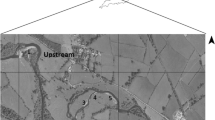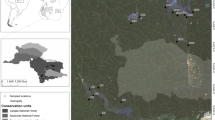Abstract
Exposed riverine sediments (ERS) are an important invertebrate habitat. Ground beetle data from pitfall trap surveys of 165 sites in the catchments of the Rivers Carron, Nith, Spey, Tweed and Eden and from 48 sites in the catchments of the Rivers Blyth, Breamish, Coquet, Glen, Pont, South Tyne, Till, Tweed and Tyne were used to produce ERS habitat classifications in Scotland and northern England respectively. Within each habitat type the quality of sites were assessed using indices based on rarity and fidelity values and using species richness as a measure of diversity. Considerable variation in these indices was seen within and between habitat types, showing potential for their use in assessing site quality and for ranking sites within habitats. The use of standardised invertebrate survey and distribution data, together with species assemblage information, for the conservation of invertebrate habitat types as an alternative to the use of selected ‘indicator species’, is discussed.
Similar content being viewed by others
References
Andersen J. 1978.The influence of the substratum on the habitat selection of Bembidiini (Col., Carabidae).Norw. J. Entomol. 25:119–138.
Andersen J. 1983. The habitat distribution of species of the tribe Bembidiini (Coleoptera, Carabidae) on banks and shores in northern Norway.Notulae Entomologicae63:131–142.
Anderson R., Nash R. and O'Connor J.P. 1997. Irish Coleoptera. A revised and annotated list. Ir. Natural. J. Special Entomol. Supplement:1–81.
Archer M.E. 1995.Aculeate wasps and bees (Hymenoptera: Aculeata) of Blaxton Common in Watsonian Yorkshire with the introduction of a new national quality scoring system.Naturalist 120:21–29.
Archer M.E. 1996. The aculeate wasps and bees (Hym., Aculeata) of Sherwood Forest in Nottinghamshire and the development of a national quality assessment scheme.Entomologist's Monthly Magazine 132:35–44.
Archer M.E. and Burn J.T. 1996. The aculeate wasps and bees of Crow Wood, Finningley in Watsonian Yorkshire, with the introduction of a new national quality scoring system.Br. J. Entomol. Nat. Hist. 8: 49–59.
Ashworth A.C. 1996.The response of arctic Carabidae (Coleoptera) to climate change based on the fossil record of the Quaternary period. Annales Zoologici Fennici33:125–131.
Atkinson T.C., Briffa K.R. and Coope G.R. 1987.Seasonal temperatures in Britain during the past 22,000 years, reconstructed using beetle remains.Nature (London) 325:587–592.
Bezdek J.C. 1981. Pattern Recognition with Fuzzy Objective Algorithms. Plenum Press, New York.
Bigot L. and Gautier G. 1982. La communauté des arthropodes des Rives de l'Ouvèze (Vaucluse). Ecologia Mediterranea8:11–36.
Boumezzough A. 1983.Les communautés animales ripicoles du bassin versant de la rivière Aille (Var-France): II) Composition et structure de la faune épiigée.Ecologia Mediterranea9:3–32.
Coope G.R. 1987. The response of late Quaternary insect communities to sudden climatic change. In: Gee J.H.R. and Giller P.S. (eds), Organisation of Communities Past Present.Blackwell Scientific Publications, London, pp. 421–438.
Coope G.R. and Wilkins A.S. 1994. The response of insect faunas to glacial-interglacial climatic fluctuations.Philosophical Transactions of the Royal Society of London, Series B344: 19–26.
Department of Environment 1995. Biodiversity: The UK Steering Group Report. 2: Action Plans. HMSO, London.
Drake M., Clements D., Eyre M., Gibbs D. and Kirby P. 1998. Invertebrates and their habitats in Natural Areas. Volume 1, Midland and Northern Areas; Volume 2, Southern Areas.English Nature Research Reports, No. 298. English Nature, Peterborough.
Edwards R. (ed.) 1997. Provisional Atlas of the Aculeate Hymenoptera of Britain and Ireland. Part 1. Biological Records Centre, Huntingdon.
Edwards R. (ed.) 1998.Provisional Atlas of the Aculeate Hymenoptera of Britain and Ireland. Part 2. Biological Records Centre, Huntingdon.
Eyre M.D. 1998. Invertebrates and the environment: a time for reassessment? Antenna22:63–70.
Eyre M.D., Ball S.G. and Foster G.N. 1985. An Atlas of the Water Beetles of Northumberland and County Durham.Hancock Museum, Newcastle upon Tyne.
Eyre M.D., Ball S.G. and Foster G.N. 1986b. An initial classification of the habitats of aquatic Coleoptera in North East England. J. App. Ecol.23:841–852.
Eyre M.D. and Lott D.A. 1997. Invertebrates of Exposed Riverine Sediments.R&D Technical ReportW11, pp.93 and R&D Project Record W1/i525/1. Environment Agency, Bristol, pp. 140.
Eyre M.D., Lott D.A. and Garside A. 1996.Assessing the potential for environmental monitoring using ground beetles (Coleoptera: Carabidae) with riverside and Scottish data.Annales Zoologici Fennici33:157–163.
Eyre M.D., Luff M.L. and Ball S.G. 1986a. An Atlas of the Carabidae (ground beetles) of Northumberland and County Durham. Hancock Museum, Newcastle upon Tyne.
Eyre M.D., Luff M.L. and Lott D.A. 1998. Rare and notable beetle species records from Scotland from survey work with pitfall traps, 1992-1996. Coleopterist7:81–90.
Eyre M.D., Luff M.L. and Lott D.A. 2000.Records of rare and notable beetle species from riverine sediments in Scotland and northern England.Coleopterist 9:25–38.
Eyre M.D., Luff M.L. and Phillips D.A. 2001. The ground beetles (Coleoptera, Carabidae) of exposed riverine sediments in Scotland and northern England.Biodiv. Cons.10:403–426.
Eyre M.D. and Rushton S.P. 1989.Quantification of conservation criteria using invertebrates.J. App. Ecol.26:159–171.
Foster G.N. 1987. The use of Coleoptera records in assessing the conservation value of wetlands. In: Luff M.L. (ed.), The Use of Invertebrate Community Data in Environmental Assessment. Agricultural Environment Research Group, University of Newcastle upon Tyne, Newcastle upon Tyne, pp.8–17.
Foster G.N. and Eyre M.D. 1992. Classification and ranking of water beetle communities.UK Nature Conservation. Vol. 1. Joint Nature Conservation Committee, Peterborough,1–110.
Foster G.N., Foster A.P., Eyre M.D. and Bilton D.T. 1990. Classi-fication of water beetle assemblages in arable fenland and ranking of sites in relation to conservation value.Freshwater Biol. 22:343–354.
Foster G.N., Nelson B.H., Bilton D.T., Lott D.A., Merritt R., Weyl R.S. et al. 1992. A classification and evaluation of Irish water beetle assemblages.Aquatic Conservation, Marine and Freshwater Ecosystems2:195–208.
Fowles A.P. 1989.The Coleoptera of shingle banks in the River Ystwyth, Dyfed.Entomologist's Record and Journal of Variation 101: 209–221.
Fowles A.P. 1994.Invertebrates of Wales: a review of important sites and species. Joint Nature Conservation Committee, Peterborough.
Fowles A.P. 1997. The Saproxylic Quality Index: an evaluation of dead wood habitats based on rarity scores, with examples from Wales.Coleopterist 6:61–66.
Fowles A.P., Alexander K.N.A. and Key R.S. 1999. The Saproxylic Quality Index: evaluating wooded habitats for the conservation of dead-wood Coleoptera.Coleopterist8:121–141.
Hill M.O. 1979a. DECORANA-A FORTRAN program for detrended correspondence analysis and reciprocal averaging. Ecology and Systematics, Cornell University, Ithaca, New York, USA.
Holmes P.R., Boyce D.C. and Reed D.K. 1993.The ground beetle (Coleoptera: Carabidae) fauna of Welsh peatland biotypes: factors influencing the distribution of ground beetles and conservation implications. Biol. Cons.63:153–161.
Höppner J. and Hering D. 1997. Uferbewohnende laufkäfer auf schotterbänken von fliessgewässern des östlichen Rheinischen Schiefergebirges. Entomologische Zeitschrift107:465–481.
Hyman P.S. and Parsons M.S. 1992. A review of the scarce and threatened Coleoptera of Great Britain. Part 1. UK Nature Conservation 3:1-484.Joint Nature Conservation Committee, Peterborough.
Hyman P.S. and Parsons M.S. 1994. A review of the scarce and threatened Coleoptera of Great Britain. Part 2.UK Nature Conservation, 12:1-248.Joint Nature Conservation Committee, Peterborough.
Luff M.L. 1996. Environmental assessments using ground beetles (Carabidae) and pitfall traps. In: Eyre M.D. (ed.), Environmental Monitoring, Surveillance and Conservation using Invertebrates. EMS Publications, Newcastle upon Tyne, pp.42–47.
Luff M.L. 1998. Provisional Atlas of the Ground Beetles (Coleoptera, Carabidae) of Britain. Biological Records Centre, Huntingdon.
Luff M.L., Eyre M.D. and Rushton S.P. 1989. Classification and ordination of habitats of ground beetles (Coleoptera, Carabidae) in north-east England.J. Biog. 16: 121–130.
Luff M.L., Eyre M.D. and Rushton S.P. 1992. Classification and prediction of grassland habitats using ground beetles (Coleoptera, Carabidae). J. Env. Manag.35:301–315.
Lyszkowski R.M. and Owen J.A. 2000. Specialist riparian beetles from riversides in Upper Strathspey, Scotland.Entomologist's Gazette 51: 133–141.
Plachter H. 1986.Composition of the carabid beetle fauna of natural riverbanks and of man-made secondary habitats. In: den Boer P.J., Luff M.L., Mossakowski D. and Weber F. (eds), Carabid Beetles, Their Adaptations and Dynamics.Gustav Fischer, Stuttgart, pp. 509–535.
Pope R.D. 1977.A checklist of British insects. In: Kloet G.S. and Hincks W.D. (eds), Handbooks for the Identification of British Insects. Vol. 11., pp. 1–105.
Ratcliffe D.A. (ed.) 1977. A Nature Conservation Review.Cambridge University Press, Cambridge.
Ratcliffe D.A. 1986.Selection of important areas for wildlife conservation in Great Britain: the Nature Conservancy Council approach. In: Usher M.B. (ed.),Wildlife Conservation Evaluation. Chapman & Hall, London, pp. 135–159.
RSPB, NRA and RSNC 1995. The New Rivers & Wildlife Handbook. Royal Society for the Protection of Birds, Sandy.
Rushton S.P., Eyre M.D. and Luff M.L. 1990. The effects of different scrub management regimes on the ground beetle fauna of oolitic limestone grassland at Castor Hanglands National Nature Reserve, Cambridgeshire, U.K. Biol. Cons.51:97–111.
Sivell S. and Phillips D.S. 1999. Local Biodiversity Plans - Technical Information on Species III. Invertebrate Animals.Scottish Natural Heritage Review, No. 5, 1–97.
Spence J.R. and Niemalä J.K. 1994.Sampling carabid assemblages with pitfall traps - the madness and the method.Can. Entomol. 126:881–894.
UK Biodiversity Group 1999. Tranche 2 Action Plans Volume 4 - Invertebrates.English Nature, Peterborough.
Usher M.B. 1986. Wildlife conservation evaluation: attributes, criteria and values. In: Usher M.B. (ed.), Wildlife Conservation Evaluation. Chapman & Hall, London, pp.3–44.
Williams P. 2000. Some properties of rarity scores used in site quality assessment.Br. J. Entomol. Nat. Hist.13:73–86.
Gardner S.M. 1991. Ground beetle (Coleoptera:Carabidae) communities on upland heath and their association with heathland flow.J. Biogeog. 18:281–289.
Author information
Authors and Affiliations
Corresponding author
Rights and permissions
About this article
Cite this article
Eyre, M., Luff, M. The use of ground beetles (Coleoptera: Carabidae) in conservation assessments of exposed riverine sediment habitats in Scotland and northern England. Journal of Insect Conservation 6, 25–38 (2002). https://doi.org/10.1023/A:1015776720125
Issue Date:
DOI: https://doi.org/10.1023/A:1015776720125




